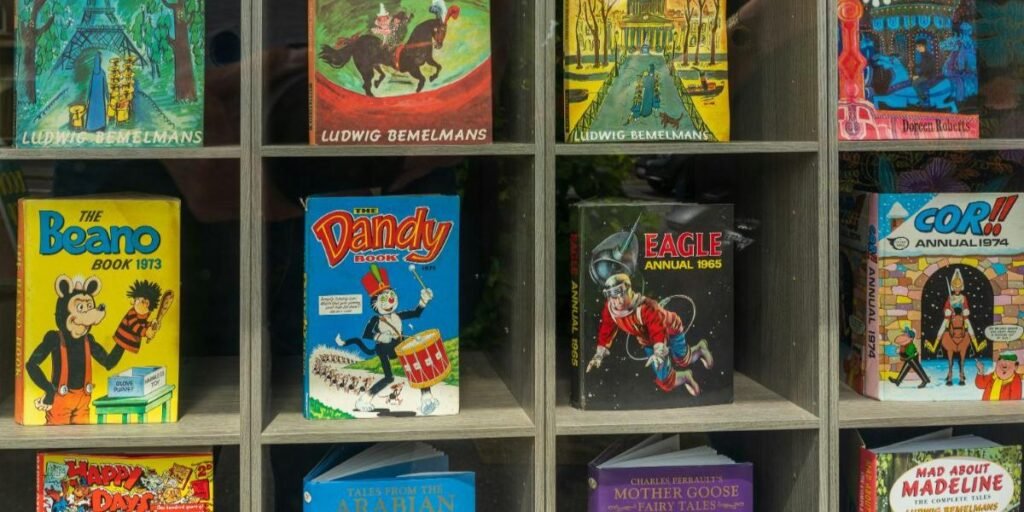Skip to the good bit
ToggleAnd it’s not just about the thrill of the chase or the pleasure in reading; it’s also a way to preserve a piece of history, to own a tangible piece of culture that connects us to different eras and ideas.
Our adventure starts with diving into the basics and understanding the driving forces behind our desire to start reading comics. Whether it’s the nostalgia, the mesmerizing artistry, compelling storytelling, or the allure of investment value, each collector’s journey is fueled by a distinct passion. It’s about charting our own course and establishing personal goals within the vibrant universe of comics.
From vintage masterpieces that hark back to the golden age of comics to contemporary works that push the boundaries of the medium, the spectrum of what we can collect is as diverse as our personalities. We learn how to start with practical tips on acquiring that first comic book and gradually build a collection that reflects our individual tastes and goals.

The basics of comic book collecting
Welcome to the exciting world of comic book collecting! In this section, we’ll explore some key essentials for getting started. From understanding the diverse genres to properly grading and storing your treasures, we’ll cover the foundation you need to build a collection you can be proud of.
Understanding comic book genres
Comic books spanning a range of genres offer us an array of storytelling that caters to different tastes. Whether you’re into the heroics of superheroes, the suspense of crime noir, or the exploratory nature of science fiction, there is something for everyone. Diving into classics like Superman or Batman from the DC Universe and Spider-man or X-Men from the Marvel Universe is a great initiation. Once you familiarize yourself with the staples, you can branch out to indie comics or genres that pique your interest.
Grading comic books
Understanding the condition and value of comic books is paramount in our collecting journey. Grading defines the book’s state and value, from ‘Mint’ (perfect) to ‘Poor’ (heavily worn). Professionals often use a 0.5 to 10 scale, with 10 being flawless. Learning to grade accurately involves examining spine stress, page quality, and cover wear. For more detailed insight, we reference grading guidelines provided by established grading companies.
Storing your collection
Proper storage ensures the longevity and preservation of our comic books. It is crucial to use archival-quality materials and keep them in a cool, dry, and dark environment. Minimizing handling and knowing safe methods for cleaning any acquired dirt or stains is also advisable. Implementing an organization system early on can also prevent headaches later in our collecting adventure, keeping issues readily accessible but well-preserved for future enjoyment.

Building your collection
Entering the world of comic book collecting is an exciting journey. We’re here to guide you on how to find comics, manage your budget, and create a collection with a unique theme.
Sourcing comic books
Starting a comic book collection requires knowing where to look. Comic book shops are traditional havens for collectors, but conventions and online marketplaces also offer vast selections. Consider following some illustrators and writers you admire to expand your collection with their works when searching for comics.
Budgeting for collecting
Collecting comics should be a passion, not a financial burden. Set a monthly budget and stick to it. Remember, starting small can lead to great things over time. Prioritize issues that hold personal value or have promising investment potential, and use digital platforms or trade paperbacks for reading copies to save money.
Collecting with a theme

Choosing a theme for your collection makes it unique. Whether you’re drawn to vintage superhero tales, independent graphic novels, or from a particular comic book run, narrowing your focus can make collecting more manageable and enjoyable. Remember, collecting is a personal endeavor, so choose themes that resonate with our interests.
Give this a try: Invincible comics – a complete guide
Preservation and care
We all want our comic book collections to stand the test of time. Ensuring that our comics remain in mint condition requires understanding the best practices for handling and displaying them.
Handling comic books
When we pick up a comic book, we must have clean hands, free of dirt or oils that can transfer to the paper and cause damage over time. It’s also beneficial to use acid-free gloves if possible. When taking proper care when handling comic books, always support the comic from the back, just like you would support the spine of a newborn baby. This prevents bending or creasing that can devalue the comic.
Displaying your comics
When we display comics, we showcase our passion and expose these treasures to potential hazards. Use UV-protected frames or holders to prevent sunlight from bleaching the vibrant colors. Ensure the comic books are stored properly in a cool, dry, and dark location to reduce the risk of paper degradation. Keep them off the floor and away from places with high humidity or drastic temperature changes.

Advanced collecting
Welcome to the deeper side of comic book collecting, where we focus on the finer aspects of the hobby. Here, we want to make the most of our passion through investment and pursuing rare and vintage pieces.
Investing in comic books
When we think about investing in comics, it’s crucial to understand the market. We always want to keep an eye out for key issues that have the potential to increase in value. For instance, first appearances and significant story arcs often attract attention. You can gain insights into what makes a comic a good investment by following market trends and observing sales histories.
Rare and vintage comics
Condition is king when it comes to collecting rare and vintage comics. These gems are often the crown jewels of our collection. We might frequent auctions or seek out specialized dealers to track down these rarities. It’s not just about rarity; the historical significance of a comic book can also amplify its value and desirability.
Frequently asked questions
As seasoned collectors, we know that diving into comic book collecting can come with many questions. The journey is exciting, and there’s much to learn, from starting your collection to potentially profiting from it.
Can you make money collecting comic books?
Yes, you can make money collecting comic books, but it’s essential to approach it with both passion and pragmatism. The key to turning a profit lies in knowing which comics to invest in, understanding market trends, and meticulously preserving their condition. Comics with historical significance, the first appearances of popular characters, and those by renowned creators are often appreciated in value. However, it’s more akin to a marathon than a sprint, requiring patience and a keen eye for potential future classics.
Are comics worth collecting?
Absolutely! Collecting comics is not just about potential financial gain; it’s a deeply rewarding hobby for enthusiasts. Beyond the monetary aspect, comics are worth collecting for their artistic, historical, and cultural value. They are a vibrant form of storytelling that captures the imagination, reflects societal changes, and brings joy to collectors. Whether you’re captivated by Jack Kirby’s artwork, fascinated by character arcs, or enamored with specific genres, comics offer something unique for everyone.
Are comic books a good investment?
Comic books can be a good investment, especially if you’re focused on rare, vintage, or key issues that have a proven track record of appreciating in value. Like any investment, there’s risk involved, so it’s crucial to research and understand what makes a comic book valuable. Factors such as rarity, demand, condition, and cultural significance play significant roles. Investing in comics should be part of a broader investment strategy balanced with a genuine love for the medium.
What comics sell the best?
Comics that typically sell the best are those that introduce iconic characters and pivotal story arcs or are created by legendary artists and writers. Limited editions, variant comic covers, and first issues of popular series also tend to perform well in the market. Historically, comics like “Action Comics #1” (the first appearance of Superman), “Detective Comics #27” (the first appearance of Batman), and other similar milestone issues are among the highest sellers.
Where are the best places to buy comics?
Finding the best place to buy comics depends on your goals. Local comic shops are perfect for supporting small businesses and finding new releases, while online marketplaces and retailers offer various options, from rare finds to the latest issues. Comic conventions and estate sales are great for exclusive editions and rare gems. Ultimately, whether you prefer the convenience of online shopping or the community aspect of local stores and events, there’s a venue to suit every collector’s needs.








